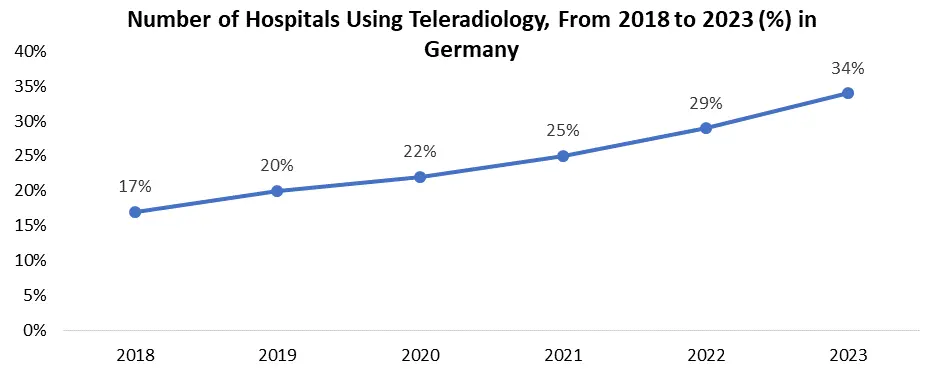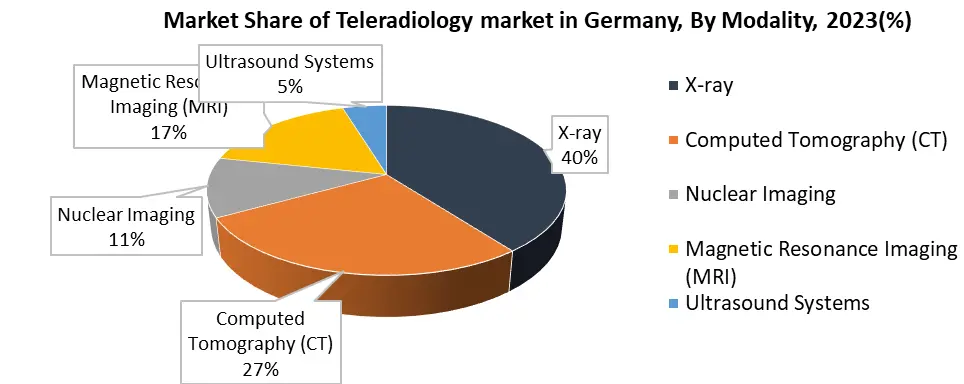The Germany Teleradiology Market size was valued at USD 95 Million in 2023. The total Germany teleradiology Market revenue is expected to grow at a CAGR of 9.8% from 2023 to 2030, reaching nearly USD 182 Million.Germany Teleradiology Market Analysis
Teleradiology is a branch of telemedicine that involves the transmission of radiological images, such as X-rays, CT scans, MRIs, and other medical imaging studies, from one location to another for interpretation and diagnosis. The growth of teleradiology in Germany is influenced by several key factors. Firstly, the aging population in the country has resulted in an increased demand for medical imaging services. Teleradiology developed as a strategic tool to fulfill the growing demand for effective diagnostic solutions that is caused by this demographic shift. Second, there is a shortage of trained radiologists in Germany, which makes it difficult to provide prompt, thorough diagnostic services. The void can be filled in a useful way by teleradiology, which gives medical professionals remote access to radiographic knowledge. Investing in AI-powered solutions is a great opportunity that holds immense potential. Developing and deploying AI-based tools designed for image analysis, reporting, and workflow optimization is expected to be a highly profitable venture. Artificial intelligence has been implemented in radiology services to improve diagnostic accuracy and increase efficiency. It puts radiologists at the leading edge of healthcare technology. The need for scalable and secure infrastructure has led to a strong opportunity in cloud-based teleradiology technologies. Healthcare providers' changing needs are met by technologies that enable safe and adaptable cloud environments for picture transmission, storage, and access. It has the potential to be met by both new and established businesses by offering advanced cloud-based technologies that guarantee lag-free connectivity and efficient data management.German Teleradiology's Present Situation and Growth Forecast
Current MMR studies indicated that 10% of imaging investigations are performed in German hospitals by using teleradiology services. It indicates that the healthcare system is using remote radiological interpretations to a moderate but not fully optimum degree. Growth forecasts indicate that with increased awareness and adoption, the utilization rate is expected to potentially double up to XX% by the year 2030. This projected growth represents a substantial opportunity for expansion, emphasizing the potential benefits and acceptance of teleradiology services within the German healthcare landscape. The latest MMR study outlines the remarkable impact on market size and indicates that an enormous growth scenario is projected in the teleradiology market. According to the report's conclusions, a specific percentage increase in utilization would provide extra revenue by 2030, assuming a baseline market size of €182 million. Important parts of the research include the exact percentage rise and associated revenue numbers, which offer strategic insights for companies starting and already functioning in the teleradiology field. The previously mentioned estimates highlight the constantly changing market and provide useful information for those involved in managing and profiting from the changing teleradiology services landscape.To know about the Research Methodology :- Request Free Sample Report Integration with AI Enhanced the Image analysis and Diagnostic accuracy AI algorithms have significantly impacted the field of radiology by providing valuable assistance to radiologists in image analysis. Because these algorithms are particularly effective at pointing out possible abnormalities, turnaround times are shortened and diagnostic accuracy is significantly increased. Research has indicated that the application of AI can lead to a substantial improvement in productivity, with up to 50% observed reductions in reporting times. It improves patient outcomes by accelerating the diagnosis process and helping to make treatment decisions rapidly. The ability of artificial intelligence to increase accuracy in radiology is one of its primary advantages, especially when it comes to the early diagnosis of diseases such as cancer and minute abnormalities. Artificial intelligence (AI) systems are capable of identifying patterns and abnormalities that are difficult for the human eye to see by utilizing sophisticated algorithms. It possibly enhances the overall reliability of diagnostic assessments by dramatically reducing the rate of misdiagnosis. According to MMR Analysis, AI software helped radiologists detect lung nodules with 95% accuracy, compared to 88% without AI.
Limited Access in Rural Areas The digital divide and limited infrastructure in rural areas present significant challenges to the increase of teleradiology in Germany. Diagnoses are delayed and specialized consultations are less common in rural areas thanks to slower access to teleradiology services. The health outcomes of people living in these underprivileged areas are adversely impacted by this imbalance in healthcare access, underscoring the larger implications of the regional disparity in the use of teleradiology. By 2030, the German government's "Digitales Land" plan hopes to have invested 2.7 billion to upgrade rural areas' digital infrastructure, which is expected to help teleradiology uptake.

Germany Teleradiology Market Segment Analysis
By Modality, the X-ray segment accounts for an estimated 42% of the overall German Teleradiology market. Compared to other modalities such as CT or MRI, X-rays are significantly cheaper, both in terms of equipment costs and scan fees. Cost-effectiveness plays a crucial role in their dominance, especially for routine examinations and in cost-conscious healthcare settings. X-ray's dominance drives the overall growth of the teleradiology market, as its widespread use generates a high volume of imaging studies requiring remote interpretation.
Germany Teleradiology Market Scope: Inquiry Before Buying
Germany Teleradiology Market Report Coverage Details Base Year: 2023 Forecast Period: 2024-2030 Historical Data: 2018 to 2023 Market Size in 2023: US $ 95 Mn. Forecast Period 2024 to 2030 CAGR: 9.8% Market Size in 2030: US $ 182 Mn. Segments Covered: by Modality X-Ray Computed Tomography Nuclear Imaging Magnetic Resonance Imaging Ultrasound Systems by Technology Cloud-based Web Based by Application Radiology Information System (RIS) Picture Archiving and Communication System (PACS) by End-User Diagnostic Imaging Center and Laboratories Long-term Care Centres, Nursing Homes, Assisted Living Facilities Hospitals and Clinics Key Players in the Germany Teleradiology Market
1. NightHawk Radiology Services 2. Calgary Scientific 3. Agfa-Gevaert Group 4. MediX4 5. teleradiologische Diagnostik Berlin (TDRB) 6. Medneo 7. NightHawk Radiology Services 8. Calgary ScientificFAQs:
1. What are the growth prospects in the Germany Teleradiology Market? Ans. The growth prospects in the Germany Teleradiology Market are promising, driven by factors such as increasing demand for remote diagnostic services, advancements in imaging technology, and the need for efficient healthcare solutions. 2. Which segments constitute the Teleradiology in Germany? Ans. Modality, Technology, application and End User. These are the segments constituted in Germany Teleradiology Market. 3. What is the projected market size & and growth rate of the Germany Teleradiology Market? Ans. The Germany Teleradiology Market size was valued at USD 95 Million in 2023. The total Germany ECG Equipment market revenue is expected to grow at a CAGR of 9.8% from 2024 to 2030, reaching nearly USD 182 Million By 2030.
1. Germany Teleradiology Market Introduction 1.1. Study Assumption and Market Definition 1.2. Scope of the Study 1.3. Executive Summary 2. Germany Teleradiology Market: Dynamics 2.1. Germany Teleradiology Market Trends 2.2. PORTER’s Five Forces Analysis 2.3. PESTLE Analysis 2.4. Value Chain Analysis 2.5. Challenges and Opportunities in the German Teleradiology market 2.6. Regulatory Landscape of Germany Teleradiology Market 2.7. Technological Advancements in Germany's Teleradiology Market 2.8. Factors Driving the Growth of the Teleradiology Market 2.9. Technological Advancements 2.10. Government Policies Reform for the Healthcare Sector in Germany 2.11. Number of Teleradiology providers in Germany 2.12. Number of Hospitals using Teleradiology 2.13. Comparison of radiologist shortage in Germany 2.14. Key Opinion Leader Analysis for Germany Teleradiology Industry 2.15. Germany Teleradiology Market Price Trend Analysis (2022-23) 3. Germany Teleradiology Market: Market Size and Forecast by Segmentation for (by Value in USD Million) (2023-2030) 3.1. Germany Teleradiology Market Size and Forecast, by Modality (2023-2030) 3.1.1. X-Ray 3.1.2. Computed Tomography 3.1.3. Nuclear Imaging 3.1.4. Magnetic Resonance Imaging 3.1.5. Ultrasound Systems 3.2. Germany Teleradiology Market Size and Forecast, by Technology (2023-2030) 3.2.1. Cloud- Based 3.2.2. Web-Based 3.3. Germany Teleradiology Market Size and Forecast, by Application (2023-2030) 3.3.1. Radiology Information System (RIS) 3.3.2. Picture Information Systems (RIS) 3.4. Germany Teleradiology Market Size and Forecast, by End Users (2023-2030) 3.4.1. Diagnostics Imaging Centre and Laboratories 3.4.2. Long-Term Care Centres, Nursing Homes, Assisted Living Facilities 3.4.3. Hospitals and Clinics 4. Germany Teleradiology Market: Competitive Landscape 4.1. MMR Competition Matrix 4.2. Competitive Landscape 4.3. Key Players Benchmarking 4.3.1. Company Name 4.3.2. Product Segment 4.3.3. End-user Segment 4.3.4. Revenue (2023) 4.4. Market Analysis by Organized Players vs. Unorganized Players 4.4.1. Organized Players 4.4.2. Unorganized Players 4.5. Leading Germany Teleradiology Market Companies, by market capitalization 4.6. Market Trends and Challenges in China 4.6.1. Technological Advancements 4.6.2. Affordability and Accessibility 4.6.3. Shortage of Skilled Professionals 4.7. Market Structure 4.7.1. Market Leaders 4.7.2. Market Followers 4.7.3. Emerging Players in the Market 4.7.4. Challenges 4.7.5. Mergers and Acquisitions Details 5. Company Profile: Key Players 5.1. NightHawk Radiology Services 5.1.1. Company Overview 5.1.2. Business Portfolio 5.1.3. Financial Overview 5.1.4. SWOT Analysis 5.1.5. Strategic Analysis 5.1.6. Details on Partnership 5.1.7. Potential Impact of Emerging Technologies 5.1.8. Regulatory Accreditations and Certifications Received by Them 5.1.9. Strategies Adopted by Key Players 5.1.10. Recent Developments 5.2. Calgary Scientific 5.3. Agfa-Gevaert Group 5.4. MediX4 5.5. teleradiologische Diagnostik Berlin (TDRB) 5.6. Medneo 5.7. NightHawk Radiology Services 5.8. Calgary Scientific 6. Key Findings 7. Industry Recommendations 8. Germany Teleradiology Market: Research Methodology